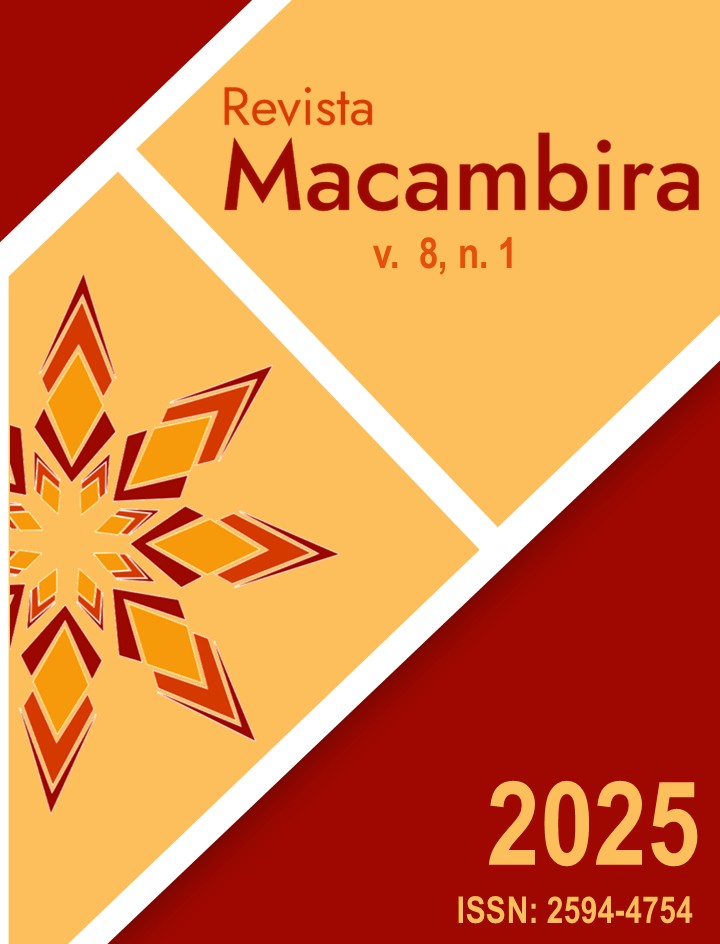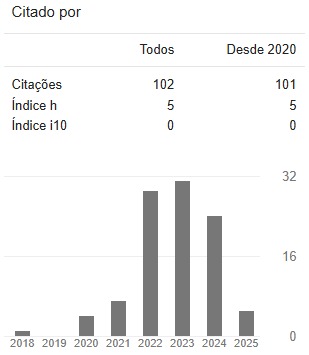Densidade de semeio de microverdes de Amaranthus cruentus sob diferentes condutividades elétricas das soluções nutritivas
DOI:
https://doi.org/10.35642/rm.v9i1.1573Palavras-chave:
Amaranto, Biomassa, Cultivo Hidropônico, RendimentoResumo
La demanda de alimentos más saludables y de producción sostenible ha llevado al sector agrícola a adoptar técnicas modernas y a explorar nuevas especies vegetales. Los microvegetales, cosechados en etapa de plántula, han ganado popularidad, pero aún faltan información sobre sus prácticas de cultivo. El objetivo del estudio fue evaluar el cultivo de microvegetales de amaranto (Amaranthus cruentus L.) bajo diferentes densidades de siembra y niveles de conductividad eléctrica (CE). El diseño experimental correspondió a un modelo de bloques al azar en parcelas divididas, con cuatro réplicas. Se utilizaron tres niveles de CE (agua de suministro – CEa de 0,3 dS m-1 y soluciones nutritivas – CEsol de 1,0 y 2,0 dS m-1) en las parcelas y cuatro densidades de siembra (25, 50, 75 y 100 g m-2) en las subparcelas. Los microvegetales de amaranto fueron cultivados bajo dichas condiciones durante ocho días en un invernadero, evaluándose los siguientes parámetros: altura de las plántulas (AP), masa fresca de las plántulas (MFP), masa seca de las plántulas (MSP), contenido de humedad de las plántulas (CHP) y masa de semillas necesaria para producir 1 kg de MFP. Los rendimientos más bajos de amaranto se registraron cuando se utilizó únicamente agua para el riego, lo que resalta la necesidad de emplear soluciones nutritivas para su cultivo. La MFP alcanzó su valor máximo con densidades de siembra de 70 y 67 g m-2 bajo una CEsol de 1,0 y 2,0 dS m-1, respectivamente. Se concluye que el amaranto puede cultivarse de manera eficiente con una densidad de siembra de 70 g m-2 y riego con una solución nutritiva a una CE de 1,0 dS m-1.
Downloads
Referências
AMPIM, P. A. Y.; OBENG, E.; GONZALEZ, E. O.; WEERASOORIYA, A.; OSUJI, G. O.; MYERS SR., D. J. The response of Egyptian spinach and vegetable amaranth microgreens to different light regimes. Scientific Journal of Biology & Life Sciences, v. 1, n. 3, p. 1-5, 2021. DOI: https://doi.org/10.33552/SJBLS.2020.01.000512
ARYA, K. S.; KUTTY, M. S.; PRADEEPKUMAR, T. Microgreens of tropical edible-seed species, an economical source of phytonutrients- insights into nutrient content, growth environment and shelf life. Future Foods, v. 8, p. 100262, 2023. DOI: https://doi.org/10.1016/j.fufo.2023.100262
BARROS, I. S.; SILVA, M. G.; SOUZA, E. S.; RODRIGUES, A. S.; SILVA, T. I.; GHEYI, H. R.; PEREIRA, G. S. J.; SACRAMENTO, L. S.; ANDRADE, A. S.; OLIVEIRA, P. S.; SANTOS, E. V. R. Densidade de semeio de microverdes de amaranto sob diferentes condutividades elétricas das soluções nutritivas. Water Resources and Irrigation Management, v. 14, n. 1-3, p. 14-29, 2025. DOI: https://doi.org/10.19149/wrim.v14i1-3.4999
BENINCASA, M. M. P. Análise de crescimento de plantas: Noções básicas. 2. ed. Jaboticabal: FUNEP, 2003. 42p.
BEZERRA, T. J.; SILVA, T. T.; LOSS, R. A.; GERALDI, C. A. Q.; GUEDES, S. F. Importance of microgreen storage conditions: Bibliometric analysis and literature review. Research, Society and Development, v. 11, n. 3, p. e25211326584, 2022. DOI: https://doi.org/10.33448/rsd-v11i3.26584
BULGARI, R.; BALDI, A.; FERRANTE, A.; LENZI, A. Yield and quality of basil, Swiss chard, and rocket microgreens grown in a hydroponic system. New Zealand Journal of Crop and Horticultural Science, v. 45 n. 2, p. 119-129, 2016. DOI: https://doi.org/10.1080/01140671.2016.1259642
COWDEN, R. J.; MARKUSSEN, B.; GHALEY, B. B.; HENRIKSEN, C. B. The effects of light spectrum and intensity, seeding density, and fertilization on biomass, morphology, and resource use efficiency in three species of Brassicaceae microgreens. Plants, v. 13, n. 1, p. 124, 2024. DOI: https://doi.org/10.3390/plants13010124
DOMÍNGUEZ-DOMÍNGUEZ, A.; HERRERA-CORREDOR, J. A.; ARGUMEDO-MACIAS, A.; RAMÍREZ-RIVERA, E. J.; LÓPEZ-ARANDA, E.; ROMERO-CRUZ, A.; LÓPEZ-ESPÍNDOLA, M. Amaranth microgreens as a potential ingredient for healthy salads: Sensory liking and purchase intent. Agroproductividad, v. 14, n. 4, p. 47-51, 2021. DOI: https://doi.org/10.32854/agrop.v14i4.1933
EL-NAKHEL, C.; PANNICO, A.; GRAZIANI, G.; KYRIACOU, M. C.; GASPARI, A.; RITIENI, A.; DE PASCALE, S.; ROUPHAEL, Y. Nutrient supplementation configures the bioactive profile and production characteristics of three Brassica L. microgreens species grown in peat-based media. Agronomy, v. 11, n. 2, p. 346, 2021. DOI: https://doi.org/10.3390/agronomy11020346
FERREIRA, D. F. Sisvar: A computer statistical analysis system. Ciência e Agrotecnologia, v. 35, n. 6, p. 1039-1042, 2011. DOI: https://doi.org/10.1590/S1413-70542011000600001
FREITAS, I. S.; MELLO, S. C.; NEMALI, K. Supplemental light quality affects optimal seeding density of microgreens. Urban Agriculture & Region Food Systems, v. 9, n. 1, p. e20064, 2024. DOI: https://doi.org/10.1002/uar2.20064.
FURLANI, P. R.; SILVEIRA, L. C. P.; BOLONHEZI, D.; FAQUIN, V. Cultivo hidropônico de plantas. Campinas: Instituto Agronômico, 1999. 52p. (Boletim Técnico, 180).
GONÇALVES-TREVISOLI, E. D. V.; MENDONÇA, H.; DILDEY, O. D. F.; DARTORA, J.; RISSATO, B. B.; COLTRO-RONCATO, S.; ECHER, M. M. Ambience and productive performance of arugula cultivated in different spacing. Scientia Agraria Paranaensis, v. 16, n. 2, p. 230-236, 2017. DOI: https://doi.org/10.18188/1983-1471/sap.v16n1p230-236
GONDIM, A. R. O.; FLORES, M. E. P.; MARTINEZ, H. E. P.; FONTES, P. C. R.; PEREIRA, P. R. G. Condutividade elétrica na produção e nutrição de alface em sistema de cultivo hidropônico NFT. Bioscience Journal, v. 26, n. 6, p. 894-904, 2010. Disponível em: https://seer.ufu.br/index.php/biosciencejournal/article/view/7228/6609. Acesso em: 20 de dez. 2024.
GUNJAL, M.; SINGH, J.; KAUR, J.; KAUR, S.; NANDA, V.; MEHTA, C. M.; BHADARIYA, V.; RASANE, P. Comparative analysis of morphological, nutritional, and bioactive properties of selected microgreens in alternative growing medium. South African Journal of Botany, v. 165, p. 188-201, 2024. DOI: https://doi.org/10.1016/j.sajb.2023.12.038
JOHNSON, S. A.; PRENNI, J. E.; HEUBERGER, A. L.; ISWEIRI, H.; CHAPARRO, J. M.; NEWMAN, S. E.; UCHANSKI, M. E.; OMERIGIC, H. M.; MICHELL, K. A.; BUNNING, M.; FOSTER, M. T.; THOMPSON, H. J.; WEIR, T. L. Comprehensive evaluation of metabolites and minerals in 6 microgreen species and the influence of maturity. Current Developments in Nutrition, v. 5, n. 2, p. nzaa180, 2021. DOI: https://doi.org/10.1093/cdn/nzaa180
KEUTGEN, N.; HAUSKNECHT, M.; TOMASZEWSKA-SOWA, M.; KEUTGEN, A. J. Nutritional and sensory quality of two types of cress microgreens depending on the mineral nutrition. Agronomy, v. 11, n. 6, p. 1110, 2021. DOI: https://doi.org/10.3390/agronomy11061110
KYRIACOU, M. C.; EL-NAKHEL, C.; GRAZIANI, G.; PANNICO, A.; SOTERIOU, G. A.; GIORDANO, M.; RITIENI, A.; DE PASCALE, S.; ROUPHAEL, Y. Functional quality in novel food sources: Genotypic variation in the nutritive and phytochemical composition of thirteen microgreens species. Food Chemistry, v. 277, p. 107-118, 2019. DOI: https://doi.org/10.1016/j.foodchem.2018.10.098
KYRIACOU, M. C.; ROUPHAEL, Y.; DI GIOIA, F.; KYRATZIS, A.; SERIO, F.; RENNA, M.; DE PASCALE, S.; SANTAMARIA, P. Micro-scale vegetable production and the rise of microgreens. Trends in Food Science & Technology, v. 57, p. 103-115, 2016. DOI: https://doi.org/10.1016/j.tifs.2016.09.005
LERNER, B. L.; STRASSBURGER, A. S.; SCHÄFER, G. Cultivation of arugula microgreens: seed densities and electrical conductivity of nutrient solution in two growing seasons. Bragantia, v. 83, p. e20230183, 2024. DOI: https://doi.org/10.1590/1678-4499.20230183.
MARTA, A. E.; STOICA, F.; OSTACI, S.; JITĂREANU, C. D. The antioxidant profile of some species of microgreens cultivated on hemp and coconut substrate under the action of a biostimulator based on humic acids. Horticulturae, v. 10, n. 12, p. 1238, 2024. DOI: https://doi.org/10.3390/horticulturae10121238
MEAS, S.; LUENGWILAI, K.; THONGKET, T. Enhancing growth and phytochemicals of two amaranth microgreens by LEDs light irradiation. Scientia Horticulturae, v. 265, p. 109204, 2020. DOI: https://doi.org/10.1016/j.scienta.2020.109204
MENDES, F. Q.; PURQUERIO, L. F. V.; CARVALHO, R. F.; CECÍLIO FILHO, A. B. White light intensities for maximum yield and quality of arugula microgreens. Pesquisa Agropecuária Tropical, v. 54, p. e79951, 2024. DOI: https://doi.org/10.1590/1983-40632024v5479951
NAGEL, J. C.; SOMMER, L. R.; FREITAG, S. F.; DRIEMEIER, D. S.; HEINZMANN, N.; VALANDRO, G. B. Produção de microverdes de alface Deva em diferentes substratos. Revista Sociedade Científica, v. 7, n. 1, p. 2507-2515, 2024. DOI: https://doi.org/10.61411/rsc202445817
NOLAN, D. A. Effects of seed density and other factors on the yield of microgreens grown hydroponically on burlap. Blacksburg: Virginia Tech, 2018. Master’s Dissertation (Online Master of Agricultural and Life Sciences In Plant Science and Pest Management). School of Plant and Environmental Sciences - Faculty of the Virginia Tech. 44p. Disponível em: https://vtechworks.lib.vt.edu/server/api/core/bitstreams/d9e94756-4eb4-4f31-9ebf-8fb6d97d5f09/content. Acesso em: 20 de dez. 2024.
NTSOANE, M. L. L.; MANHIVI, V. E.; SHOKO, T.; SEKE, F.; MABOKO, M. M.; SIVAKUMAR, D. The phytonutrient content and yield of brassica microgreens grown in soilless media with different seed densities. Horticulturae, v. 9, n. 11, p. 1218, 2023. DOI: https://doi.org/10.3390/horticulturae9111218
OLIVEIRA, F. A.; FREITAS, R. S.; OLIVEIRA, M. K.; SANTOS, S. T.; COSTA, J. P. B.; MORAIS NETA, H. M.; MARQUES, I. C.; CORDEIRO, C. J. X. Electrical conductivity of the nutrient solution for soilless cultivation of kohlrabi. Horticultura Brasileira, v. 40, n. 2, p. 129-135, 2022. DOI: https://doi.org/10.1590/s0102-0536-20220201
PALMITESSA, O. D.; RENNA, M.; CRUPI, P.; LOVECE, A.; CORBO, F.; SANTAMARIA, P. Yield and quality characteristics of Brassica microgreens as affected by the NH4:NO3 molar ratio and strength of the nutrient solution. Foods, v. 9, n. 5, p. 677, 2020. DOI: https://doi.org/10.3390/foods9050677
PINHEIRO, W. D.; WIETH, A. R.; CARVALHO, A. C.; DUARTE, T. S.; SILVA, M. A. S. Hydroponic rocket under different densities and solution concentrations in the autumn and winter period. Brazilian Journal of Development, v. 7, n. 3, p. 23206-23220, 2021. DOI: https://doi.org/10.34117/bjdv7n3-165
PORTELA, I. P.; PEIL, R. M.; ROMBALDI, C. V. Effect of nutrient concentration on growth, yield and quality of strawberries in hydroponic system. Horticultura Brasileira, v. 30, n. 2, p. 266-273, 2012. DOI: https://doi.org/10.1590/S0102-05362012000200014
RAJAN, P.; LADA, R. R.; MACDONALD, M. T. Advancement in indoor vertical farming for microgreen production. American Journal of Plant Sciences, v. 10, n. 8, p. 1397-1408, 2019. DOI: https://doi.org/10.4236/ajps.2019.108100
SANTOS, F. L.; COSTA, E. S.; LIMA, C. S. M. Diferentes substratos no desenvolvimento e na pós-colheita de microverdes de beterraba (Beta vulgaris L.). Revista Iberoamericana de Tecnología Postcosecha, v. 21, n. 2, p. 233-243, 2020. Disponível em: https://www.redalyc.org/journal/813/81365122008/81365122008.pdf. Acesso em: 20 de dez. 2024.
SIGNORE, A.; SOMMA, A.; LEONI, B.; SANTAMARIA, P. Optimising sowing density for microgreens production in rapini, kale and cress. Horticulturae, v. 10, n. 3, p. 274, 2024. DOI: https://doi.org/10.3390/horticulturae10030274
SILVA, M. G.; GHEYI, H. R.; SILVA, L. L.; SOUZA, T. T.; SILVA, P. C. C.; QUEIROZ, L. A.; SANTOS, T. S.; SOARES, T. M. Evaluation of salt and root-zone temperature stresses in leafy vegetables using hydroponics as a clean production cultivation technique in northeastern Brazil. Horticulture, Environment and Biotechnology, v. 65, n. 1, p. 95-118, 2024b. DOI: https://doi.org/10.1007/s13580-023-00547-6
SILVA, M. G.; GOMES, E. G. S.; SACRAMENTO, L. S.; PEREIRA, G. S. J.; GHEYI, H. R.; SILVA, T. I. Implantação de módulo hidropônico no Colégio Municipal Poeta Castro Alves em Cabaceiras do Paraguaçu, Bahia. Revista Macambira, v. 8, n. 1, p. e081044, 2024c. DOI: https://doi.org/10.35642/rm.v8i1.1539
SILVA, M. G.; SACRAMENTO, L. S.; PEREIRA, G. S. J.; RIBEIRO, M. C. B. O.; BARROS, I. S.; GHEYI, H. R. Rocket microgreen cultivation under seeding densities and nutrient solution concentrations. Water Resources and Irrigation Management, v. 13, n. 1-3, p. 60-71, 2024a. DOI: https://doi.org/10.19149/wrim.v13i1-3.4795
WIETH, A. R.; PINHEIRO, W. D.; DUARTE, T. S. Purple cabbage microgreens grown in different substrates and nutritive solution concentrations. Revista Caatinga, v. 32, n. 4, p. 976-985, 2019. DOI: https://doi.org/10.1590/1983-21252019v32n414rc.
WOLOSIK, K.; MARKOWSKA, A. Amaranthus cruentus taxonomy, botanical description, and review of its seed chemical composition. Natural Product Communications, v. 14, n. 5, p. 1-10, 2019. DOI: https://doi.org/10.1177/1934578X19844141
WRUBEL, E. J.; KOESTER, D. L.; LIMA, C. S. M.; SANTOS, E. R. Crescimento e pós-colheita de microverdes de couve-manteiga (Brassica oleracea var. Acephala L.) sob influência de diferentes recipientes e substratos. Brazilian Journal of Food Research, v. 13, n. 4, p. 18-36, 2022. DOI: https://doi.org/10.3895/rebrapa.v13n4.17150
YADAV, L. P.; KOLEY, T. K.; TRIPATHI, A.; SINGH, S. Antioxidant potentiality and mineral content of summer season leafy greens: Comparison at mature and microgreen stages using chemometric. Agricultural Research, v. 8, n. 2, p. 165-175, 2018. DOI: https://doi.org/10.1007/s40003-018-0378-7
YUSOH, W.; MALAEH, W.; RUANGRAK, E. Increasing qualities of amaranth microgreens under plant factory system by LED light. In: Insan Junior Researchers International Conference, 2022, Nilai. Proceedings… Nilai: Kolej GENIUS Insan USIM, 2022. Disponível em: https://www.researchgate.net/publication/369414565_Increasing_Qualities_of_AmaranthMicrogreens_Under_Plant_Factory_System_by_LED_light. Acesso em: 20 de dez. 2024.
Downloads
Publicado
Edição
Seção
Licença
Copyright (c) 2025 Revista Macambira

Este trabalho está licenciado sob uma licença Creative Commons Attribution 4.0 International License.












